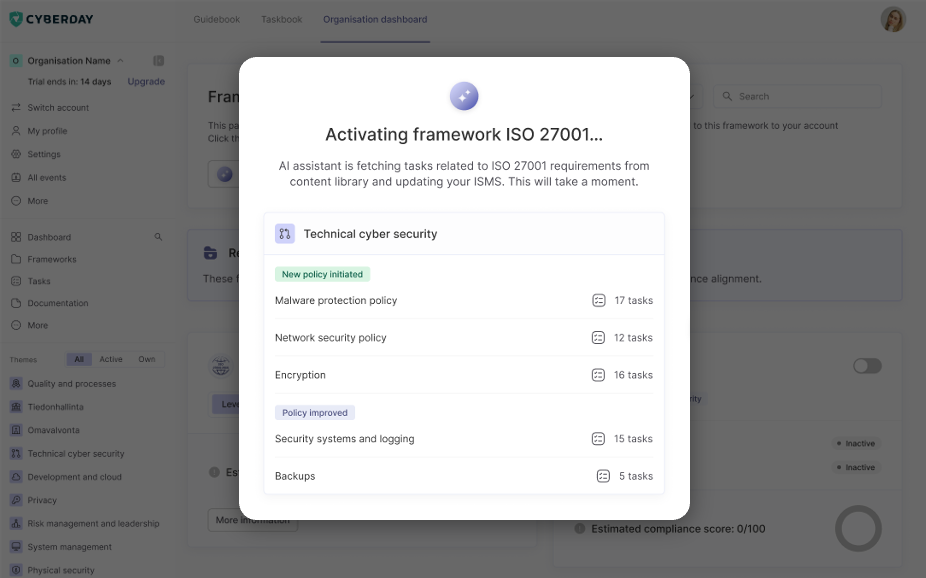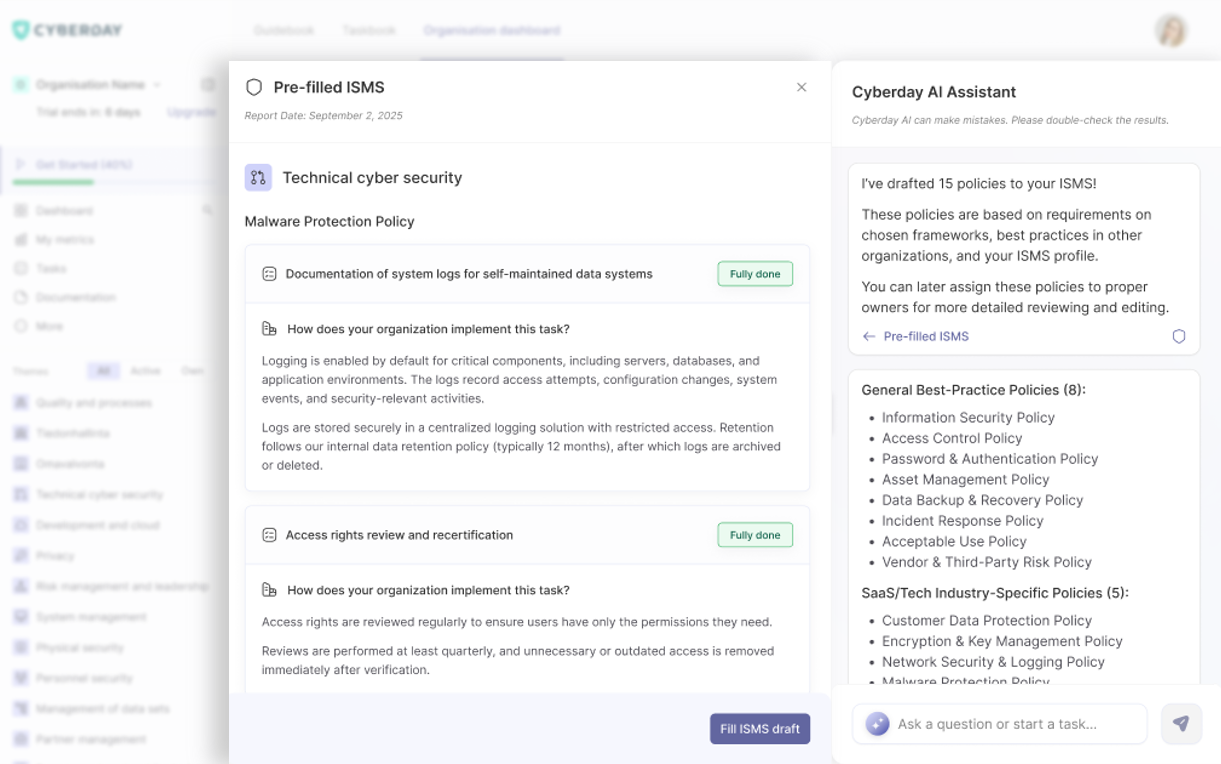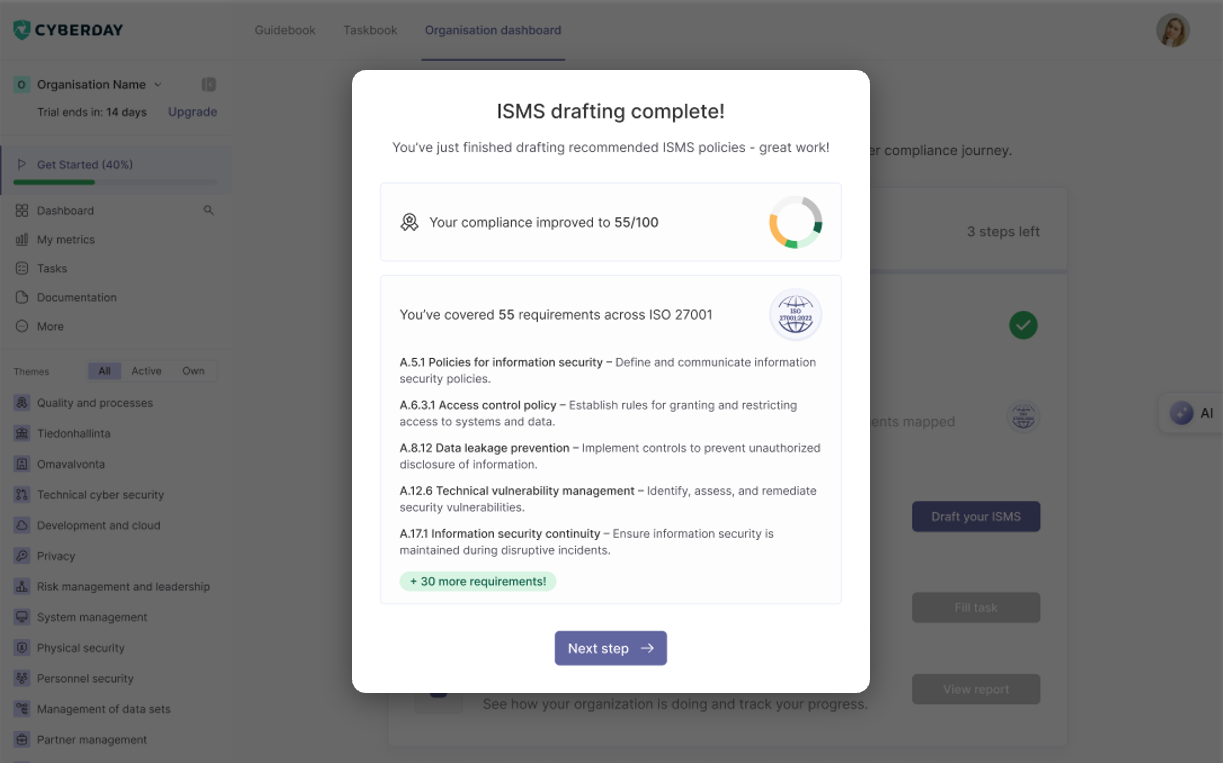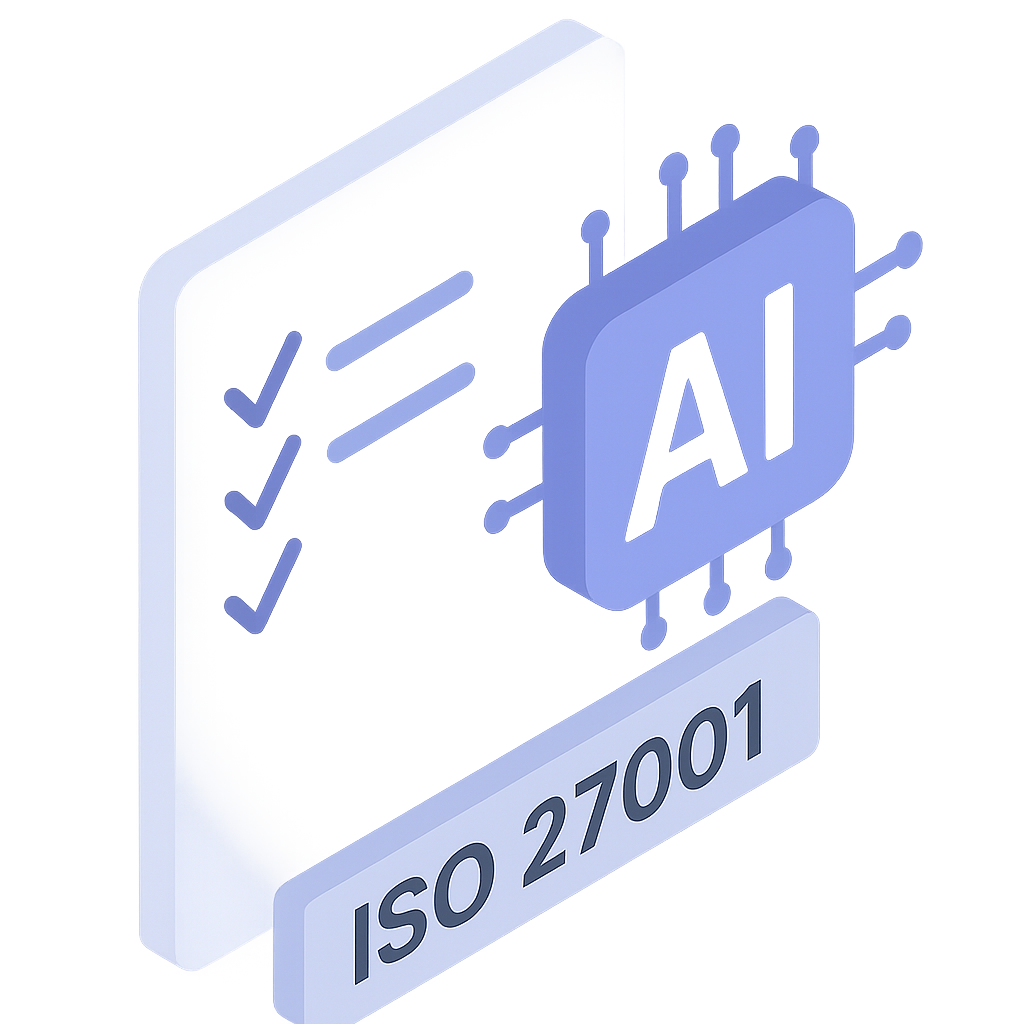Even getting started on ISO 27001 compliance work used to require months of documentation work, cross-team coordination, and guessing what the “right level” of security might look like for your organization.
By combining the power of AI and modern ISMS platforms, this process can become dramatically more efficient.
This is the first article in a blog series on how to streamline ISO 27001 compliance using AI.
This part focuses on on building the ISMS baseline. We'll explain how AI can be used in a controlled way, so the generated output is relevant, tightly focused on your exact compliance goals and structured for efficient human implementation and monitoring. The essential steps for ISMS baseline building with Cyberday AI are:
- Creating your ISMS profile: To guide the AI to accurate output
- Activating correct frameworks (if not just ISO 27001): To define relevant things to do, map to requirements and report on framework compliance
- Drafting the ISMS baseline with AI: To get a ton of relevant best practice content created to your ISMS in minutes, and give a flying start to your compliance work
This all can be done in minutes, instead of weeks, so your time can be saved for implementing security - not writing documents. 🚀
1. AI-driven ISMS profiling: The foundation for an accurate, AI-drafted ISMS
Often the ISO 27001 work is started by drafting a bunch of policies, using examples from other organizations or generic AI for assistance.
This can feel productive because you get a big document created quickly - but because as the content is produced without understanding your actual organization and information security environment, it becomes:
- Too generic
- Hard to implement
- Disconnected from reality
- Misaligned with your real risks
- Something you have to rewrite again later
Policy documents do not constitute a working ISMS.
Without a proper "ISMS profile", all AI can do is generate a template policy full of abstractions. These aren’t helpful to teams or auditors, they’re burdensome.
Cyberday solves this by starting from a structured ISMS profile that describes your real organization. All AI-generated content will use this profile, along with the activated frameworks, as its context.
What goes into an effective ISMS profile?
Organization type: Name, primary industry, secondary industries, country
These determine your baseline requirements and security emphasis.
- Industry affects which controls matter most (healthcare ≠ SaaS ≠ finance)
- Country influences regulatory obligations and data processing expectations
- Industry-specific threat patterns shape risk modeling
Organization size: Team size, structure, locations
Size influences the expected maturity of governance and HR-related controls.
- Larger organizations = more focus on personnel security, onboarding/offboarding, access controls
- Distributed teams = more complex asset and identity management
- Scaling orgs need clearer responsibilities and review cycles
Activity summary: What you deliver, to whom, and how
This defines the core ISMS scope and risk landscape.
Pursued ISMS maturity: Certification level, good-practice level or minimum effort
Not all organizations aim for certification immediately.
- Determines how formal governance must be
- Influences which tasks are required now vs. later
- Avoids overwhelming early-stage organizations
Information security specifics: E.g. own software development, existing certifications, critical partners
These details shape the nuance of your ISMS.
- Doing own software development requires SDLC, code review, CI/CD controls
- Existing certifications allow reuse of existing documentation
- Outsourced development or cloud reliance changes supplier-risk tasks
How this is done in Cyberday?
In Cyberday, this ISMS profiling is the very first step that gets done during the onboarding.
AI assistant can do all the heavy-lifting for you. You just give it your public website domain, and it fills the profile for you.

Why this step matters?
A strong profile turns your ISMS into something that fits your organization - not a generic template.
It ensures that:
- AI-generated content is relevant
- Controls are appropriate
- Tasks are actionable
- Risks reflect reality
- Policies become meaningful summaries
It’s the fuel that makes the rest of your AI-driven ISO 27001 compliance work efficient.
2. Picking frameworks: Turning requirements into actionable tasks (with multi-compliance automation)
Most organizations don’t operate under a single framework anymore. ISO 27001 frequently combines with:
- NIS2 and local NIS2 implementations for operational security of essential services
- SOC 2 for US market assurance
- CIS Controls for technical safeguards
- ISO 27701 for privacy
Traditionally, this meant maintaining separate documents, separate control lists, and separate audits.
But with a task-based system, it works very differently.
In Cyberday, picking the framework determines:
- Which requirements apply to you
- Which tasks you need to implement
- For which frameworks compliance score is tracked for
Many frameworks overlap between eachother. Through Cyberday's task-based approach and multi-compliance automation, you'll get the "do once, comply with many" effect.
This means all the tasks included in your plan are automatically mapped into all relevant requirements in active frameworks - for limited compliance effort, maximun effects.
How this is done in Cyberday?
This is where the power of AI + a task-based ISMS becomes obvious.
When you activate a framework in Cyberday, the AI assistant goes to work and communicates the effects on your ISMS. With the first framework you'll get lots of new content, but with the later expansions less and less.

Tasks are framework-mapped: Each task is linked to all requirements it satisfies. If a quarterly access review contributes to complying with ISO 27001 A.5.18, NIS2 Article on access management, CIS 6.3, SOC 2 CC6.1…you still perform one task, attach one piece of evidence, and improve your compliance towards all of them.
Adding a new framework to your ISMS doesn’t create chaos: If you first start small, and later add a new framework, Cyberday automatically understands the overlap and communicates you the compliance score against a framework - even before activating it. At any point you will understand, how compliant your current ISMS makes you against any information security framework. When you activate a new framework, your ISMS plan is extended with only the new tasks that aren't yet covered through other frameworks.
Why this step matters?
Choosing frameworks in Cyberday produces:
- A combined, deduplicated task list
- Automatic multi-framework mappings
- Reduced workload
- Clear responsibility and evidence collection
- Policies that update themselves
- Audit readiness for multiple standards with minimal extra effort
Framework selection no longer creates complexity - it creates efficiency.
3. ISMS drafting: Let AI write your first 80% of the ISMS
With the ISMS profile created and relevant frameworks picked, AI can continue the work by drafting your ISMS.
This step doesn't produce you a list of long governance documents.
It creates you a set of tasks to implement, that's based on your profile and best practices - and will get you compliant towards your selected frameworks. Policies equal the readable output of these tasks, they are not separate from one another.
What Cyberday AI generates at this stage
Using your ISMS profile, Cyberday’s AI creates:
- Best-practice tasks for relevant controls
- Pre-filled descriptions of how each task is usually implemented
- Suggested owners based on role and size
- Evidence templates describing what should be collected
- Automatically generated policy summaries

This gives you a structured, accurate ISMS baseline in minutes - not weeks.
You'll immediately see the effect of the AI-drafted baseline on your current compliance score. The assurance score will keep on monitoring the amount of evidence on the ISMS to prove that the compliance score is correct, and increasing that is where human expertise is needed.

How work should be continued with human expertise?
AI can create the baseline, but people are needed define the reality.
Your team continues from the AI-created draft to finalize the tasks by:
- Selecting actual responsible persons
- Finetuning the implementation descriptions and setting e.g. review frequencies
- Filling in related evidence using linkings, examples and templates in the ISMS
To summarize: the AI-drafted baseline will need to be adjusted to fit your culture and existing processes, and the implementation monitored through owners and ISMS automation.
The outcome: Starting point for a working, living ISMS
By combining:
- An ISMS profile
- Framework selection with multi-compliance support
- AI-driven ISMS drafting
…you get an ISMS that is:
- Relevant
- Actionable
- Audit-ready
- Maintainable
- Evidence-driven
- Continuously improving
And you avoid the trap of producing large, generic documents that add no value.
If you want to see it in action, create your ISMS in minutes right now.


























